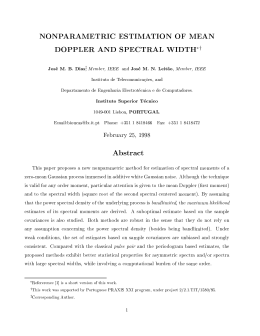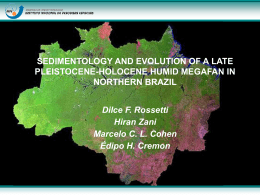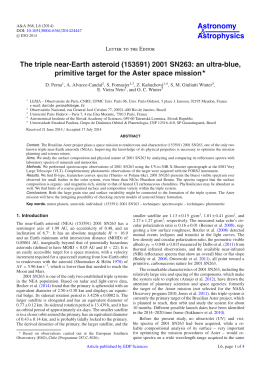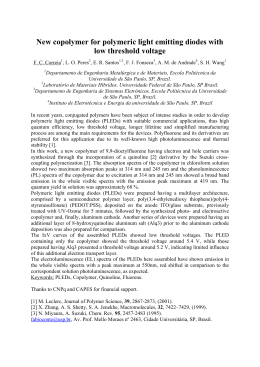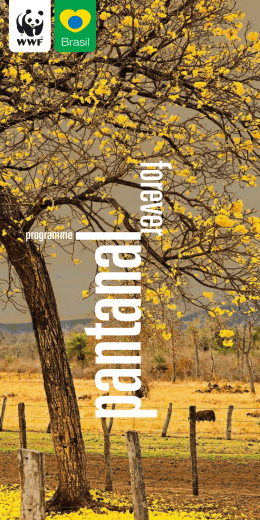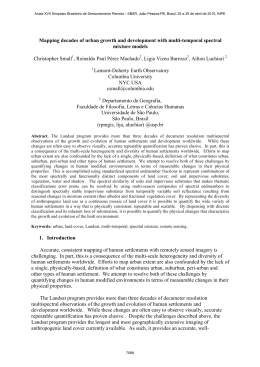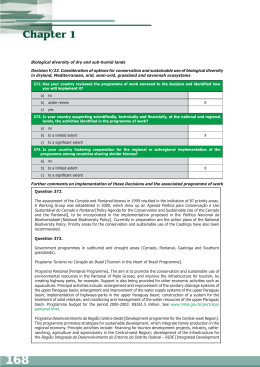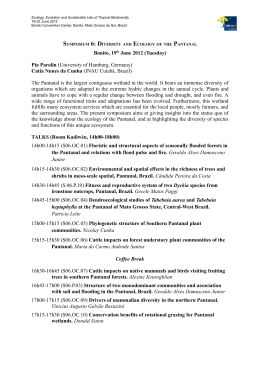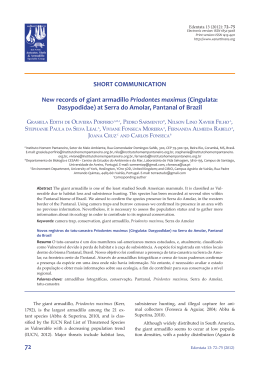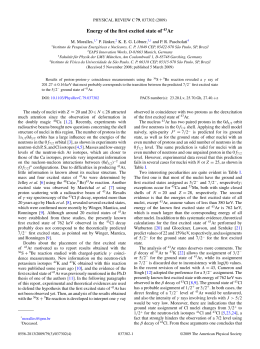COMPARISION OF VELOCITY SPECTRA DURING THE PASSAGE OF A COLD FRONT OVER PANTANAL Gannabathula S.S.D.Prasad 1*, K.P.R.Vittal Murty2*, Leonardo D.A. Sá1,Bart Kruijt3, Amaury de Souza4 1 DCM/Instituto Nacional de Pesquisas Espaciais, São José dos Campos, SP Andhra University, Waltair, INDIA,3Institute of Ecology and Resource Mangement, University of Edingurth, Edinburgh UK.,4Dept. de Física/Universidade Federal do Mato Grosso do Sul * CNPq fellow 2 ABSTRACT: In this article the velocity spectra was examined over Pantanal region on two contrasting days. One is a clear day and the other is a cloudy day with passage of a cold front. It is observed that there is a shift in the spectral energy maximum on a clear day indicating more shear production. KEY WORDS: Velocity Spectra, Cold front, Surface Layer, Pantanal INTRODUCTION The gradient observations data measured by sensitive instruments provide an opportunity to study the structure of the surface layer and its variation during passage of large synoptic scale weather phenomena like passage of a front etc(Garret 1988). Van der Hoven (1957) analysed the horizontal velocity spectrum which showed two eddy energy peaks. The first bigger one corresponds to synoptic scale (a period of approximately 4 days) and the other small peak ( a period of approximately one minute) corresponds to microscale motions. Between these two peaks the spectral energy is less (0.5 to 10 cycles per hour) which is known as the Spectral Gap. However, Kaimal (1973) showed that atmospheric boundary layer can have eddy motions with periods ranging from several minutes to three hours within the spectral gap. In this paper the horizontal and vertical velocity spectra obtained from the fast response sonic anemometer data at 24 meters measured at pantanal during the Interdiciplinary Pantanal Experiment#1(IPE1) was compared for two Julian days 136 and 143. The former is a cloudy day with a passage of cold front and the latter is a clear sunny day. The idea is to obtain changes in the structure of the surface layer for different synpotic situations. MATERIALS AND METHODS The spectra of the u, v and w were obtained using a three dimensional sonic anemometers and was sampled at 20.8samples per second. The spectra were computed using the procedure suggested by Kaimal(1973). The data records are first checked for consisteny and any spurious spikes if any were deleted. The Welsh periodogram was computed using an fft of size 4096 samples. The record size was selected as 90minutes and care was taken to see that the actual data length is an exact multiple of 4096 samples. This ensures that there is no zero padding. A low frequency spectrum was also computed and the two spectra were then added. The trend present in the data was removed before computing the spectra. The results are shown in figures1 and 2. All the figures were drawn on a loglog scale. The lines in the figures have a slope of –2/3. RESULTS The spectra depending on the availability of the data is estimated at 00hours, 06:00hours and 18:00 hours on day 136 and at 00, 06:00 , 12:00 and 18:00hours on day 143. The shear production zone of turbulance is upto 0.01 cycles and the spectral maximum also conicide within this frequency . Then the spectral energy is dissipated following the –2/3 power law of the inertial range. The cluster is more in the lower frequencies and it is less in the shear production zone. Comparing the day 143 the maximum shift toward the positive side and in the night there is more spectral gustiness and it is much smoother at 18:00hours. This may be due to the strong instability at 12:00hours and the presence of the Brunt-Vaisala oscillatons and the presence of gravity waves in the night. So the main difference observed between the day 136 and 143 is the shift in the maximum, indicating more shear production on the day 143 which is a clear day compared to the day 136 which is cloudy. CONCLUSIONS: The important difference in the velocity spectra is the shift in the spectra maximum. It shifts towards the positive frequency during a clear day compared to a cloudy day with the passage of the cold front. The spectral gustiness is more in the night for both the clear and cloudy days. This may be attributed to the presence of the gravity waves. ACKNOWLEDGMENTS The authors would like to thank, FAPESP (proc. #98/00105-5) and the CNPq (procs.# 381.699/97-8, 381.690/97-0and 139.164/96-0) for the finanacial support. Thanks are also due to all the people involved in the IPE-1 Project organization and dat collection: Drs Antonio O Manzi, Regina C.Santos Alvalá, Clovis A Sansigolo, Ralf Gielow, Plinio C.A.Alvalá, Clovis M. do Espirito Santo and Messrs. Paulo R.A.Arlino, Luis E. Rosa, Celso Randow, Jorge Martins de Melo, Sabrina B.M.Sambatti, Elizabete C.Moraes all of INPE. Acknowldgements are also due to Drs. Edson Kassar, Lhamilton G. Pavão, Masao Uetanabaro and Mrs. Carla Muller, Jorge Gonçalves and Waldeir M.Dias of Universidade Federal do Mato Grosso do Sul, Yadvinder Malhi of University of Edinburgh, Dr. Maria Lucia Meirelles of EMBRAPA/CPC, Dr. Romisio G.G.André of UNESP/Jaboticaba Special Thanks are also due to Dr. Nelson L. Dias of SIMEPAR and Dr. Paulo H.Caramori of IAPAR who provided a sonic anemometer and hygrometer for use duing the campaign. REFERENCES Garrat J.R (1988),”Summer time cold front in south-east Australia – Behaviour and low – level structure of the main frontal types”, Mon. Wea. Review., 116, 636-649. Kaimal J.C (1973),”turbulence spectra, length scale and structure parameters in the stable surface layer”, Boundary. Lay. Met., 4, 289-309 Prakash J.W.J, Ramachandran R., Nair K.N., SenGupta K., and KunniKrishnan C.K. (1993), “On the spectral behaviour of the atmospheric boundary layer parameters at thumba “, Quarterly Journal of the Royal Met. Soc., 119, 187-197. Smith R.K., and Reeder M.J. (1988), “On the movement anof low level structure of cold fonts”, Mon. Wea. Review., 116, 1927-1944. Van der Hoven (1957), “Power spectrum of horizontal wind speed in the frequency range from 0.0007 to 900 cycles per hour”, J. Meteorol, 14, 160-164.
Download
